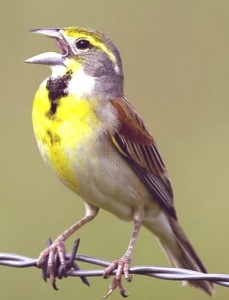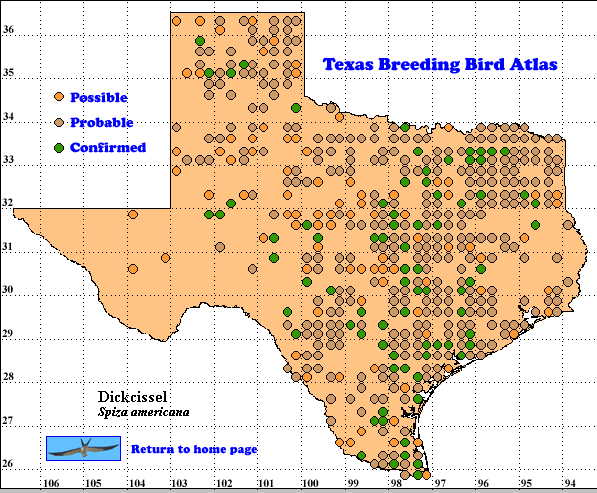Oberholser (1974) aptly described Dickcissel as a “sparrow-sized meadowlark.” Size and plumage pattern distinguish the male from any other species within its breeding range; females and immatures (duller than the male) can only be confused with female House Sparrows (Passer domesticus), not usually a grassland nester (Temple 2002).
This species which breeds in and migrates through Texas, arrives after a nocturnal flight from its winter home primarily in the llanos of central Venezuela, or from wintering areas in Central America by way of the Gulf coastal plain of Mexico. Over water migrants probably stop in Texas to rebuild body fat reserves after arriving from South America or before returning (Oberholser 1974).
DISTRIBUTION. During the 1987-1992 field work for the TBBA project volunteers found most confirmed breeding sites for Dickcissel east of the 100th meridian and in the northern Panhandle, with a few sites just south of the Panhandle. Only a few possible/probable reports were found in Trans-Pecos Texas and these may be migrants, as may some possible/probable reports from other parts of the state.
Outside Texas Dickcissels breed from North Dakota (east of the Missouri River), Minnesota, Wisconsin and lower Michigan, south to the Gulf Coast of Louisiana. The core breeding area, where about 70% of the population breeds, extends from eastern Nebraska and southern Iowa south through Kansas and western Missouri to central Oklahoma with another area in Arkansas along the Mississippi River. Breeding also occurs sporadically though much of the United States east of the Rocky Mountains. This species apparently does mot have a strong year-to-year fidelity to breeding and wintering sites. The sporadic, irregular year-to-year changes in breeding areas and abundance make atlasing Dickcissel a challenge (Temple 2002).
The prime wintering area of the Dickcissel is the seasonally flooded grasslands north of the Orinoco River in central Venezuela (llanos). The species also winters in lowlands of Colombia and along the west coast of Middle America from Mexico to Panama (Temple 2002)
SEASONAL OCCURRENCE. Dickcissel migrates north through Texas from March 10 to June 13 with peak movement from late March to mid-May. The species breeds from early April to mid-August with egg dates from April 16 to July 30. TBBA field workers found nest building occurring from May 4 to June 2, birds on or around nests from May 8-18, young being fed from May 27 to July 5, and recently fledged young from May 9-July 29. The species moves south from July 10 to November 23 with the peak flight from late July to mid-October (Oberholser 1974).
BREEDING HABITAT. In Texas Dickcissel breeds from near sea level to 1150 m (3800 ft). In wet years (more than 60 cm [24 in] of rain) many Dickcissels remain in Texas to breed where grasses and forbs, especially Johnson grass, sorghum and sunflowers grow lush among scattered bushes. The nest, built by the female in about 4 days, is a bulky cup of grasses, roots, leaves, corn leaves, plant stalks and mosses, lined with fine grasses, thin stems of forbs and horsehair. The nest is well hidden
on the ground in grass clumps, forbs, alfalfa, and bushes. It may also be in a tree up to 6 m (20 ft) above the ground. The outside diameter of the nest is about 12 cm (5 in), height 6 cm (2.5 in), inside diameter 6-7 cm (2.5 in), inside depth 4.5 cm (1.8 in).
The usual clutch is 4-5 (range 3-6) unmarked eggs of various shades of blue to green-blue . The eggs are indistinguishable from those of the Lark Bunting (Calamospiza melanocorys). The female Dickcissel incubates the eggs for 11-12 days, occasionally starting after laying the next to last egg. Two broods are typically raised each year (Oberholser 1974, Harrison 1979).
STATUS. Lockwood and Freeman (2004) describe Dickcissel as an uncommon to locally abundant summer resident and migrant east of the Pecos River; Numbers vary from year to year, depending on winter and spring precipitation.
Although Oberholser’s (1974) map reports summer records and a breeding record from Trans-Pecos Texas, the TBBA map has no confirmed records for that region. The difference may not be significant as Oberholser’s map covers a much longer time span than the 1988-1992 field work period of the TBBA and Temple (2002) indicates Dickcissel is a nomadic and opportunistic breeder, nesting in the most favorable areas in any given year. Oberholser (1974) suggests the breeding population in Texas is highest in years of high rainfall.
Data from the Breeding Bird Survey (BBS) for 1994-2003 show the highest breeding densities of Dickcissels in Texas are found in the Red River valley south to the 32nd parallel at relative abundances of 30-100 birds per 40 km (25 mi) route. Densities decrease from here south through the Post Oak Savannah and Blackland Prairies, Gulf Coastal plain and South Texas Brush Country to 10-30 individuals per route. The BBS method detected almost no Dickcissels in the Trans-Pecos (Sauer et al. 2004).
BBS data provide a 95% confidence interval for the trend of -2.1 to 6.3% population change per year for the Dickcissel in Texas during 1966-2003 (there is a 95% probability that the actual trend will fall between these two values). Across the United States, BBS data show a statistically significant decline of 1.2% per year. Averaging over an area this large allows calculation of a significant trend for this species with wide local year-to-year variations (Sauer et al. 2004).
BBS data also suggest that Texas is an important part of the breeding range for Dickcissel, since Texas provided 139 of the 922 BBS routes (15%) on which the species was detected in the United States (Sauer et al. 2004. Text by Robert C. Tweit (2006)
Literature cited:
Harrison, H. H. 1979. A field guide to western birds’ nests. Houghton Mifflin, Boston, MA.
Lockwood, M. W. and B. Freeman. 2004. The TOS handbook of Texas birds. Texas A&M University Press, College Station.
Oberholser, H. C. 1974. The bird life of Texas, Vol. 2. University of Texas Press, Austin.
Sauer, J. R., J. E. Hines, and J. Fallon. 2004. The North American Breeding Bird Survey, results and analysis 1966-2003. Version 2004.1. USGS Patuxent Wildlife Research Center, Laurel MD (Web site, http://www.mbr-pwrc.usgs.gov/bbs).
Temple, S. A. 2002. Dickcissel. (Spiza Americana). In The birds of North America, No. 703 (A. Poole and F. Gill, eds.). The Birds of North America, Inc., Philadelphia, PA.

